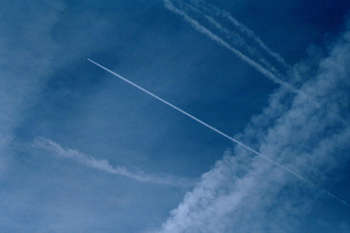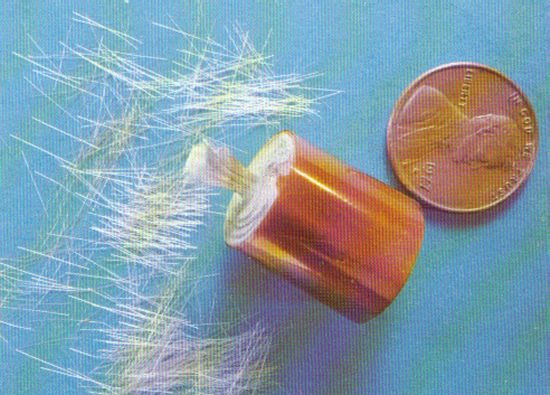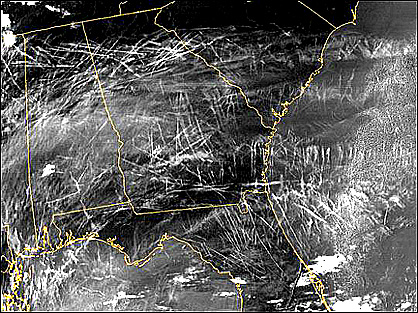Modern armed forces use chaff (often deployed with short-ranged SRBOC rockets) to distract radar-guided missiles from their targets. Most military aircraft and warships have chaff dispensing systems for self-defense. An intercontinental ballistic missile may release in its midcourse phase several independent warheads, a large number of decoys, and chaff.
Chaff can also be used to signal distress by an aircraft when communications are not functional. This has the same effect as an SOS, and can be picked up on radar. It is done by dropping chaff every 2 minutes.
According to military sources, Chaff is simply a training aid used in specific overland restricted airspace while jets are conducting training. It is not used in the enroute airspace over the continental USA - in other words while flying under the FAA control to and from the bombing range. Likewise, aircraft do not jam radar frequencies unless in an approved piece of Restricted airspace. Dispensing chaff is a training aid used while the jets are performing on the bombing or electronic warfare range, in order to train in one of the avoidance measures a jet can take to break a radar lock from a threat such as a Surface to Air missile. Fallon is a big Navy traing base for their fighter pilots, so they will dispense quite a bit of chaff on a daily basis, but only on a "postage stamp" size of restricted airspace and only while training against those electronic threat simulators. There is a handful of such bombing and electronic warfare ranges around the country. Most are in the western USA where there is room to fly and train in various combat maneuvers. For what it's worth, most chaff is dropped just a few hundred feet off the ground. Not anywhere close to the contrail/chemtrail stuff going on about 30,000 feet and higher.
Most comments from the military will suggest that Chaff is a relic left over from the Vietnam War.
However the company that is the primary manufacturer of Chaff in the world may argue that point. From 1996 to 2003 Esterline Technologies based in Bellevue Washingtion has had US defence contracts totalling over $252 million. From 2002-2003 its contracts grew from $36 million to $116 million. Half of the contracts to the Pentagon has been catagorized as "Research and Development".
Researchers and environmentalists are beginning to take notice since the new generation of Chaff has aluminized fiberglass particles which can stay in the air for 20-hours or longer. And when mixed with fuel additives and other emmissions there becomes a real risk of several layers of aerial deception: weather modification, electronic controls, atmospheric heating (HAARP) and a whole stew of other interests.
Testing of substances such as Chaff also comes into question. Who does the testing, the manufacturer, military or a scientific agency? And where? It becomes a labrynth difficult to track, and very political.
On a side note, Esterline should be considered a small military contractor however, over 90 percent of Esterlines contract revenues with the Pentagon were awarded to them without an open competiton in otherwords closed and in-camera. Esterline could also be considered a Republican Party supporter, between 1998 and 2003 it contributed over $142,000 for various candidates including $6600 directly to President Bush. They donated nothing to Democrats.
In July of 2006, the Idaho Observer published a story about a family in Iowa which had approached Senator Tom Harkin (D-IA) to report the constant criss-crossing of "chemtrails" in the sky above their neighborhood. They received back from the senator's office a Unitied States General Accounting Office (GAO) Report on "military chaff" and the material safety data sheet for aluminum-coated fiberglass fibers being spreadseven days a week for several hours each dayin the skies above their home.
The report suggested "chemtrails" may really be a huge use of military "chaff." The Observer reported: "Once chaff reaches the ground, it breaks down into particles small enough to inhale. Though military spokespeople insist that chaff is not harmful, the GAO report concluded that health effects are unknown and more studies are needed. "
"The 1998 GAO noted that: (1) chaff is used worldwide in conjunction with military training, testing, and other assigned missions; (2) in fiscal year (FY) 1997, the Air Force reported using about 1.8 million bundles worldwide, Navy and Marine Corps aircraft used more than 354,000 bundles and 593 rolls, and Navy combat ships used about 10,000 large bundles; (3) DOD records indicate that FY 1998 inventories include more than 37 million bundles and more than 141,000 rolls of chaff; (4) the Air Force holds about 77 percent of the bundles, while the Navy and Marine Corps hold all the rolls; (5) the Army has some mission needs but possesses and uses little chaff in peacetime training or testing; (6) while DOD components report that chaff is an effective means of defense for aircraft, ships, and related weapons systems, DOD and other agencies have identified some unintended and potential side effects of chaff; (7) chaff can affect safety by interfering with air traffic control radar; (8) chaff can also affect weather radar observations and the operation of friendly radar systems, especially when vehicles stir up chaff that has settled on the ground; (9) the services have a number of ongoing initiatives to address concerns about the unintended and potential effects of chaff; (10) for example, DOD has entered into or is negotiating agreements with other federal agencies to address issues related to commercial air safety, weather forecasting, and environmental impacts on public lands; (11) also, the Navy has started a program to develop degradable chaff that is estimated to cost about 40 percent more than the current chaff; (12) while intended as beneficial, the Navy has not yet defined the operational and environmental benefits that could result from this program; (13) notwithstanding DOD's actions, some concerns continue to be raised by the public and federal agencies about the potentially harmful or undesirable effects of chaff on the environment; (14) also, some of DOD's studies cite additional areas where questions have been raised about the unintended effects of chaff; (15) DOD has not systematically followed up on these questions or on the recommendations of these reports to determine whether they merit additional review; and (16) DOD continues to retain lead-based chaff in its inventory even though this type of chaff has not been manufactured since 1987 and is reportedly no longer in use.
(The full GAO Report: http://www.fas.org/man/gao/nsiad-98-219.htm)
The Las Vegas Journal-Review reported in 2000 that a Naval Research Laboratories report in particular was questioned:
"The report highlights the Department of Defense's lackadaisical attitude towards human health risks by giving a green light to continued use of chaff while noting that several health questions remain unanswered," according to Grace Potorti, director of the Reno-based Rural Alliance for Military Accountability.
The US military contends that there's no harm to use of chaff, however the magnitude by which chaff is dumped over continental United States in significant. On example area might be in 2000 in the vicinity of Fallon Naval Air Station, located in Nevada.
About one-third of the 42,000 annual military flights based out NAS Fallon use chaff in the course of their training missions. Over the previous five years, the amount of chaff annually dispensed of over the Fallon Military Operating Area averaged about 1/4 ounce per acre. The Navel Research report describes, the chemical composition of chaff is essentially the same as desert dust, and the amounts expended into the environment are several orders of magnitude less than EPA standards for dust, vehicle exhaust, power generation and industry.
But by 1998 reports such as the GAO stated that there was in was an increased use of "chaff" planned:
"The continuous stream technique, called saturation chaff, may be used by aircraft to cover a large area. By 2005 or 2006, the Army also plans to use saturation chaff to mask vehicle and troop movements. Using a cutter, 360 pounds of chaff from nine 40-pound rolls can be deployed in 10 minutes. Depending on the method and the number of aircraft, such releases could disperse billions of fibers. The B-52 can carry about 750 seven-ounce boxes of chaff; each box contains up to 11 million fibers that can be expelled continuously or in bursts. Most chaff bundles contain millions of fibers. For example, the chaff bundles used most by the Air Force (RR-188) and the Navy (RR-144) contain more than 5 million individual fibers each, and the Navy's Zuni rocket warhead (RR-182) contains more than 100 million fibers."
So the question remains, what level of chaff dispersement is taking place today?
The Defense Advanced Research Projects Agency (www.darpa.mil) notes in their [unclassified] FY 2007 budget buried on page 363 of 453 that "chaff" may have an important role in standoff explosives and concealed weapons detection:
"The Standoff Explosives and Concealed Weapons Detection program will develop a standoff system for the detection of improvised explosive devices (IEDs), suicide bombs and vehicle bombs that have become weapons of havoc and destruction in current urban operations; as well as a low cost concealed weapons detection system. This program will explore various phenomenologies that may permit explosive detections. The first approach will examine chemical approaches such as spectrometry using IR photothermal signature of the explosive compounds, or standoff detection using molecular tags that change physical, electronic, or optical properties upon exposure to emitted vapors. These tags provide specific molecular information on the signature chemicals, thus enhancing specificity in the cluttered environment. They could be deployed as dust or chaff that can be dispersed in the air or sprayed on suspect vehicles, or into larger sensor structures that could be used to integrate the concentration of vapor over time."
Whether current "chaff" operations are already using "chemical tags" for identification is not known. However, what is known is that whether by intent or accident, the reports on the web that "chemtrail residue" contain many other chemicals/contaminants, may in fact be justified claims.
With electronic warfare and it's opposite, electronic countermeasures (along with electronic counter-counter measures) being a fertile purchasing area for corporate defense contractors, it's expected that chemtrails/chaff use will continue to increase.
Presently the Defense Advanced Research Projects Agency (DARPA) which is the central research and development agaency for the US Department of Defence are attempting to tie
"chaff" to real current military problems like improvised explosive devices (IED's) in battle zones like Iraq.
Like depleted uranium (DU) munitions, banned by the UN but used by the US, there's no civilian oversight of health consequences of either long term DU or "chaff"/chemtrail use in the United States, and perhaps even a lesser consideration, Canada.
Newfoundland recently performed an official environmental assessment of chaff because the Canadian Department of Defence had applied test countermeasure in that province at 5 Wing Goose Bay.
According study report Chaff is described as a radiofrequency countermeasure released by military aircraft, ships, and vehicles to confuse enemy radar. Chaff consists of aluminum-coated glass fibers ranging in lengths from 0.8 to 0.75 cm and is released in packets of 0.5 to 100 million fibers.
The Department of Defense has determined that use of chaff in training is required for maintaining proficiency in the use of this countermeasure. At least 500 tons of chaff is released annually during training within selected military operating areas in the United States. Concerns have been raised about impact on the environment and its potential toxicity to humans, livestock, and wildlife. Many of these concerns have been addressed or are being researched by the Department of Defense and other agencies, but much of the data are unpublished.
The final report published was mainly a review of literatiure supplied by the US Department of Defence, it would very little risk to the environment if chaff was used during training flights. However the report idenetified Cold Lake Alberta and Goose Bay Labrador being the two approved locations for the dispersment of chaff during training exercises. In total 2500 NATO training sorties release 7.2 tones of chaff in this two locations every year.
However this acceptable explanation holds true when one applies it to 'normal air traffic' and quite often is the foundation argument agaist the Chemtrail explanation. But simply put, Contrails occur during specific atmospheric conditions or only in certain altitudes when it's cold enough to turn the water vapor to ice. This again has nothing to do with, nor explains why Chemtrails are seen during any and all weather conditions, at varying heights in the sky, during all times of the year, all across the US, Canada and other countries. There are even reports that some are sprayed so low, people report smelling the chemicals in them.
What are chemtrails? According to anti-Chemtrail activists They resemble jet contrails in that they start out as a white line of 'trail' from an aircraft. Unlike contrails, they can be very low and are sometimes tinged with oranges, yellows or purples or even reflect oily rainbows in them. Instead of being that crisp "sky scraper" line, they are thick and clumpy and often appear to 'drip'. They slowly fan out to a "spider web" hazy cloud cover that spans a large section of sky. Reports of 60-mile "cloud systems" from a single
Chemtrail spray has been reported. According to one activist, "It's obvious when you see one that it's a spray of "material" or chemicals and not normal "water vapor" that the thin contrails are made of. Analysis of chemtrail spray have turned up powdered aluminum, barium, pathogens and even dried human blood cells".
Patrick Minnis, who seems to be the appointed "anti-chemtrail" spokesman at NASA's Langley Base has an alternative explanation, as a reaearcher he's studied satellite photos of the airplane jetstreams, which occur only when the sky is moist, close to forming thin clouds. What he discovered may sound far-fetched - but the evidence is clear.
For example, a distinctive oval-shaped contrail left behind by a test flight drifted across California for six hours, finally turning into a 60-mile-long cloud system. "We were very excited because it opened our eyes up to the fact that there's possibly a lot of clouds up in the sky that were originally contrails," Minnis said.
In another case, a figure-8 cloud created its own 60-mile swath of clouds over Texas and Louisiana over a nine-hour period.
Contrails or Chemtrails, evidence is surfacing that air pollution from air traffic is on the rise and may be seeding jetstreams at valarming rates. NASA's Bruce Anderson actually went aloft to follow in the turbulent wake of a contrail. He came up with a theory for the role of contrails in causing atmospheric moisture to condense into clouds.
"We do know that the sulfur in the fuel from aircraft generate aerosol particles, and those in turn can influence the formation of clouds," Anderson said. Could jet-caused clouds be enough to affect climate?
"The number of clear days over the U.S. has decreased in the last 30 years, and we suspect that much of that is due to an increase in cirrus clouds, which we suspect is probably due to an increase in air traffic," Minnis said. And if such clouds trap heat, could they even contribute to global warming?
"That connection to the greenhouse effect is still murky. But there is evidence that contrail clouds can have a big impact on weather patterns. In the wake of Hurricane Nora, researchers got their most dramatic view yet: Moist air blanketed the nation's midsection from Nebraska to Texas, and scores of contrails fused into one enormous cloud - stretching for more than 800 miles.", said Minnis.
In fact Chemtrail activists may be right, air traffic is spreading harmful substances over populated areas. And while governments may reject the notion that this is a dilebrate measure to poison the population, they have not as yet tested the harmful effects that contrail emmissions may be having on people and the environment.
What poses an even greater threat is a possible coverup of both harmful emmissions, biological experiements and the degree of air-traffic far above the flights officially logged. This infomration problem exists dues to the differences between poloitical platformas, and weather political leadership believes that climate change is real or not.





